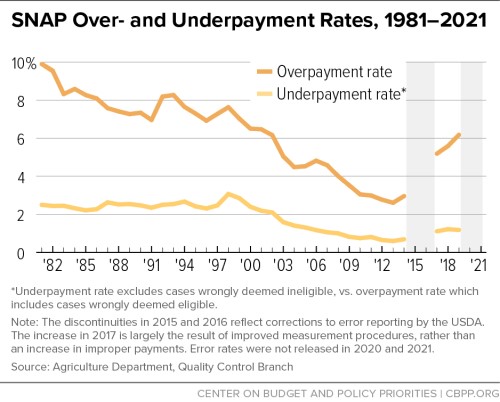Supplemental Nutrition Assistance Program recipients were overpaid at a rate of 9.84% in fiscal 2022 and underpaid by 1.7% on average as state agencies struggled with staffing coming out of the pandemic, according to USDA.
Error rates for individual states varied widely. Alaska had the highest overpayment rate at 56.69%, followed by Maryland at 32.65%. South Dakota had the lowest overall error rate at 3.07% of underpayments and overpayments.
SNAP payment error rates measure how accurately state agencies determine household eligibility and benefit amounts. USDA resumed publication of state SNAP error rates for FY22 after pausing during the pandemic. In 2019, error rates averaged 6.18% for overpayments and 1.18% underpayments.
FY22 started Oct. 1, 2021 and ran through Sept. 30, 2022.
A joint statement from Senate Agriculture Committee Chairwoman Debbie Stabenow, D-Mich., ranking member John Boozman, R-Ark., House Agriculture Committee Chairman Glenn Thompson, R-Pa., and ranking member David Scott, D-Ga., said the national error rate is “unacceptable and threatens the integrity of the program.”
“We urge governors and administrators to promptly establish corrective action plans and continue to work with USDA to address the root causes of these errors to improve their program operations, remain accountable to the taxpayer, and most importantly, ensure that benefits are targeted to the people who are the most in need,” the statement noted.
Stacy Dean, USDA's deputy undersecretary for food, nutrition and consumer services, said state SNAP workers had to respond quickly to the rising number of people who needed food assistance during the pandemic.
“However, these circumstances also put incredible strain on program administration,” Dean said. “The first state-by-state set of payment error rates coming out of the pandemic reflects the challenging circumstances under which the state agencies were operating, and from which many are continuing to recover.”
USDA said staff vacancies at state agencies were as high as 25% as the pandemic lingered and states agencies had difficulty hiring and training new case managers.
Gina Plata-Nino, SNAP deputy director at the Food Research and Action Center, said the pandemic created a very “delicate time” for those trying to serve SNAP recipients as case workers themselves were switching from in-person to remote. “There was also a lot of people who left the workforce, and state agencies had to hire new people.” Plata-Nino told Agri-Pulse.
Dottie Rosenbaum, director of federal SNAP policy at the Center on Budget and Policy Priorities, and Katie Bergh, CBPP senior policy analyst, wrote in a blog that SNAP has one of the most rigorous payment accuracy systems and helps drive state and federal program officials’ decisions. They also rarely represent dishonesty or fraud.
“Given its nature, the exact extent of fraud is difficult to pinpoint, but it is clear that the overwhelming majority of SNAP errors result from honest mistakes by recipients, eligibility workers, data entry clerks or computer programmers,” Rosenbaum and Bergh wrote.
They added that USDA reported in 2019 half of overpayments and 80% of underpayments were states’ fault and “most others resulted from simple errors by households, not intentional fraud.”
USDA said, “Importantly, because of the temporary policy circumstances in place during the pandemic, the overpayment rates do not directly equate to a loss to the government.”

The payment error rates reflect payment accuracy of the regular SNAP benefit, but in fiscal year 2022, 45 states were providing emergency allotments, USDA said. “The overpayment rate does not account for the fact that, while some households received an overpayment of their basic SNAP benefit, the combined total of regular SNAP plus their emergency allotment payment did not exceed the capped amount allowed by law,” USDA said.
Individual households are required to pay back overpayments, even if it was the state agency’s fault. States also issue corrections for underpayments.
USDA said it will notify states that are at risk of financial penalties if they do not lower their fiscal year 2023 error rate. USDA can fine states that increase error rates two years in a row.
Don’t miss a beat! It’s easy to sign up for a FREE month of Agri-Pulse news! For the latest on what’s happening in Washington, D.C. and around the country in agriculture, just click here.
Dean said the department "is committed to supporting states in improving payment accuracy in SNAP to ensure the program effectively and efficiently serves those who need it and promotes good stewardship of taxpayer dollars. We are doubling down to work with state partners to find ways to decrease payment errors and tackle the issues aggressively at their root cause.”
Rosenbaum and Bergh say in their blog post that a state SNAP program "should not be considered successful if it has high payment accuracy but low take-up, or if challenges in accessing it impose a significant tax on participants in terms of time and resources.”
“Unfortunately, during more normal times, SNAP’s performance measurement system is heavily tilted to payment accuracy. The program does far too little to measure and prioritize access,” Rosenbaum and Bergh say. “And policymakers and the public often lack adequate information about how well the program is performing in terms of the human experience of applying for and maintaining benefits.”
They add the upcoming farm bill provides an opportunity for “improvements to SNAP performance metrics that would better balance payment accuracy with customer service and ensuring timely access. It is critical that SNAP’s success also be measured for the way it centers participants’ experience and makes benefits accessible to people in all areas of the country.”
They also said that Congress should build in new “vital signs” into state SNAP performance measures to help better understand the human experience of obtaining and retaining SNAP benefits. These metrics could be done by identifying call center answer rates and wait times, procedural denials of applications and recertifications, churn of cases that lose coverage during a renewal and overall customer satisfaction.
For more news, visit www.Agri-Pulse.com.


